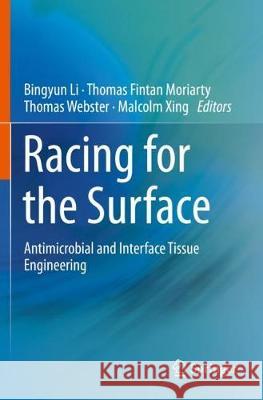Racing for the Surface: Antimicrobial and Interface Tissue Engineering » książka



Racing for the Surface: Antimicrobial and Interface Tissue Engineering
ISBN-13: 9783030344733 / Angielski / Miękka / 2021 / 809 str.
Racing for the Surface: Antimicrobial and Interface Tissue Engineering
ISBN-13: 9783030344733 / Angielski / Miękka / 2021 / 809 str.
(netto: 576,41 VAT: 5%)
Najniższa cena z 30 dni: 578,30
ok. 22 dni roboczych
Bez gwarancji dostawy przed świętami
Darmowa dostawa!
Part I: Innovative antimicrobial and osteoinductive therapeutics.- Advances in antimicrobial and osteoinductive biomaterials.- Recent Advances in Controlled Release Technologies for the Co-Delivery of Antimicrobial and Osteoconductive Therapeutics.- Biofilm-inhibiting and osseointegration-promoting orthopedic implants with novel nanocoatings.- Three dimensional (3D) and drug-eluting nanofiber coating for prosthetic implants.- Cationic antimicrobial coatings with osteoinductive properties.- Peptide Functionalized Biomaterials with Osteoinductive or Anti-biofilm Activity.- Construction of bio-functionalized ZnO coatings on titanium implants with both self-antibacterial and osteoinductive properties.- Gasotransmitters: antimicrobial properties and impact on cell growth for tissue engineering.- Carbon nanotubes: Their antimicrobial properties and applications in bone tissue regeneration.- Part II: Interface tissue engineering and advanced material for scaffolds.- Fracture healing and progress towards successful repair.- Animal models for bone tissue engineering and osteoinductive biomaterial research.- Bioprinting in Tissue Engineering.- Additive Manufacturing of Bio-scaffolds for Bone Regeneration.- Anti-biofouling and Antimicrobial Biomaterials for Tissue Engineering.- Osteoinductive and osteoconductive biomaterials.- Bimetallic nanoparticles for biomedical applications: a review.- Peptide-mediated Bone Tissue Regeneration.- Antibody mediated osseous regeneration - a new strategy for bioengineering.- Extracellular matrix-based materials for bone regeneration.- Calcium Phosphate Biomaterials for Bone Tissue Engineering: Properties and Relevance in Bone Repair.- Bioactive Glasses in Orthopedic Applications.- Advances in Tissue Engineering and Regeneration.- SCAFFOLDS FOR TISSUE ENGINEERING: A state of the art review concerning types, properties, materials, processing and characterization.- Recent Developments of Zn-Based Medical Implants.- Recent physical interaction-based bioadhesives.- Tellurium, the forgotten element: a review for the properties, processes and biomedical applications of the bulk and nanoscale metalloid.- Index.
Bingyun Li is a full Professor with tenure at School of Medicine, West Virginia University. He is a Fellow of the American Institute for Medical and Biological Engineering and an Associate Editor of the Frontiers in Microbiology journal. Professor Li is a member of the Society for Biomaterials (SFB), Orthopedic Research Society (ORS), American Society for Microbiology (ASM), Materials Research Society (MRS), American Chemical Society (ACS), International Chinese Musculoskeletal Research Society (ICMRS), and Chinese Association for Biomaterials (CAB). Professor Li has served as topic chair of Infection and Inflammation of the ORS Program Committee, vice-chair and chair of Orthopedic Biomaterials Special Interest Group of SFB, Chief Editor of ICMRS Newsletter, and inaugural treasurer of CAB. Professor Li’s research focuses on advanced materials, nanomedicine, infection, immunology, and drug delivery. He has published two edited books, 102 articles, 133 abstracts, and 14 provisional/full patents. Professor Li has given 56 invited and keynote talks and has received multiple prestigious awards including the Berton Rahn Prize from AO Foundation, the Pfizer Best Scientific Paper Award from Asia Pacific Orthopedic Association, and the Collaborative Exchange Award from Orthopedic Research Society.
This book covers the key basics of tissue engineering as well as the latest advances in the integration of both antimicrobial and osteoinductive properties. Topics covered include osteoconductive and osteoinductive biomaterials (calcium phosphate, bone morphogenetic protein, peptides, antibodies, bioactive glasses, nanomaterials, etc.) and scaffolds. Research integrating both antimicrobial/biofilm-inhibiting and osteoinductive/osteoconductive properties and their co-delivery is detailed and their roles in clinical success are discussed. Combined with its companion volume, Racing for the Surface: Antimicrobial and Interface Tissue Engineering, this book bridges the gap between infection and tissue engineering, and is an ideal book for academic researchers, clinicians, industrial engineers and scientists, governmental representatives in national laboratories, and advanced undergraduate students and post-doctoral fellows who are interested in tissue engineering and regeneration, infection, and biomaterials and devices.
1997-2025 DolnySlask.com Agencja Internetowa
KrainaKsiazek.PL - Księgarnia Internetowa








